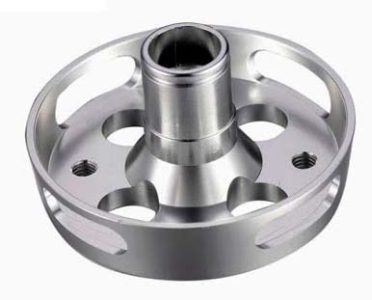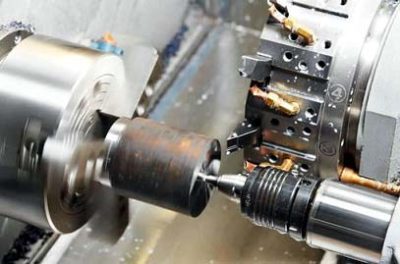Categorias de Produtos
Etiquetas de produto
Técnico para peças de processamento de torno CNC
O que é processamento de torno?
Aquilo é, no torno, a forma e o tamanho da peça bruta são alterados pelo movimento rotativo da peça de trabalho e pelo movimento linear ou curvo da ferramenta, e processado para atender aos requisitos das peças de desenho.
O que é processamento de torno?
Aquilo é, no torno, a forma e o tamanho da peça bruta são alterados pelo movimento rotativo da peça de trabalho e pelo movimento linear ou curvo da ferramenta, e processado para atender aos requisitos das peças de desenho.
Turning is a method of cutting the workpiece by using the rotation of the part relative to the tool on the lathe. The cutting function of turning is mainly provided by the workpiece rather than the tool. Turning is the most basic and common cutting method, and it occupies a very important position in production. Turning is suitable for machining revolving surfaces, and most workpieces with revolving surfaces can be processed by turning methods. Such as inner and outer cylindrical surface, inner and outer conical surface, end surface, groove, thread and rotary forming surface, etc., the tools used are mainly turning tools.
Among all kinds of metal cutting machine tools, lathes are the most widely used, accounting for about 50% of the total number of machine tools. The lathe can not only use turning tools to turn the workpiece, but also use drills, alargadores, taps and knurling tools for drilling, reaming, tapping and knurling operations. De acordo com diferentes características do processo, formas de layout e características estruturais, tornos podem ser divididos em: Tornos horizontais, tornos de piso, tornos verticais, tornos de torre e tornos de perfilamento, etc., a maioria dos quais são tornos horizontais.
O processamento de torno CNC pode processar vários tipos de materiais. Há: 316, 304 aço inoxidável, Aço carbono, aço para ferramentas, Liga de aço, liga de alumínio, Liga de magnésio, Liga de Zinco, Liga de titânio, cobre, ferro, plástico, acrílico, POM, UHWM e outras matérias-primas. Pode processar peças com estruturas complexas.
Precauções para processamento de torno CNC
A tecnologia de processamento do torno CNC é semelhante à do torno comum. No entanto, porque o torno CNC é uma fixação única, processamento contínuo e automático para completar todos os processos de torneamento. Portanto, os seguintes aspectos devem ser prestados atenção:
1. Escolha razoável da quantidade de corte:
For high-efficiency metal cutting processing, the processed material, ferramentas de corte, and cutting conditions are the three major elements. These determine the processing time, tool life and processing quality. The economical and effective machining method must be the reasonable choice of cutting conditions.
Three elements of cutting conditions: Cutting speed, feed rate and depth of cut directly cause tool damage. With the increase of cutting speed, the temperature of the tool tip will rise, which will cause mechanical, chemical and thermal wear. Cutting speed increased by 20%, tool life will be reduced by 1/2. The relationship between the feed condition and the wear on the back of the tool occurs in a very small range. No entanto, the feed rate is large, the cutting temperature rises, and the tool wear is large. It has less influence on the tool than cutting speed. While the impact of the cutting depth of the tool is not as cutting speed and feed large. No entanto, when cutting at a small depth of cut, the material being cut produces a hardened layer, which will also affect the life of the tool.
The user should choose the cutting speed to be used according to the processed material, dureza, cutting state, material type, taxa de alimentação, and depth of cut. The most suitable processing conditions are selected on the basis of these factors. Regular, stable wear and longevity are the ideal conditions. No entanto, in actual operations, the choice of tool life is related to tool wear, dimensional changes to be processed, Qualidade da superfície, cutting noise, and processing heat. When determining the processing conditions, it is necessary to conduct research according to the actual situation. For difficult-to-machine materials such as stainless steel, heat-resistant alloys, titanium alloys, and magnesium alloys, coolants or turning blades with good rigidity can be used.
2. Choose a tool reasonably:
(1) When rough turning, choose a tool with high strength and good durability to meet the requirements of large turning depth and large feed when rough turning.
(2) When finishing turning, choose tools with high precision and good durability. To ensure the requirements of machining accuracy.
(3) In order to reduce the time of tool change and facilitate tool setting, machine clamp tools and machine clamp turning blades should be used as much as possible.
3. Reasonable selection of fixtures:
(1) Try to use general fixtures to clamp the workpiece and avoid using special fixtures;
(2) The positioning datums of the parts coincide to reduce positioning errors.
4. Determine the processing route: The processing route is the movement track and direction of the tool relative to the part during the processing of the index-controlled machine tool.
(1) It should be able to guarantee the processing accuracy and surface roughness requirements;
(2) The processing route should be shortened as much as possible to reduce the tool idle travel time.

máquina cnc para torneamento de alumínio

machine tool processing machinery parts

turning brass auto parts manufacturing

Clamping for lathe machining
5. The relationship between processing route and machining allowance:
Under the condition that the CNC lathe has not reached the popular use, the excess margin on the blank, especially the margin containing the forging and casting hard skin layer, should be arranged on the ordinary lathe for processing. If you must use a CNC lathe for processing, you need to pay attention to the flexible arrangement of the program.
6. Main points of fixture installation:
The connection between the hydraulic chuck and the hydraulic clamping cylinder is realized by a tie rod. The main points of hydraulic chuck clamping are as follows:
Primeiro, remove the nut on the hydraulic cylinder with a moving hand, remove the pull tube, and pull it out from the back of the spindle. Then use the moving hand to remove the chuck fixing screw to remove the chuck.
Contate-nos
Aguardando seu e-mail, responderemos dentro de 12 horas com informações valiosas que você precisava.
 English
English العربية
العربية 中文(漢字)
中文(漢字) Čeština
Čeština Dansk
Dansk Nederlands
Nederlands Suomi
Suomi Français
Français Deutsch
Deutsch Italiano
Italiano 日本語
日本語 ಕನ್ನಡ
ಕನ್ನಡ 한국어
한국어 Português
Português Русский
Русский Slovenčina
Slovenčina Español
Español Svenska
Svenska Türkçe
Türkçe





